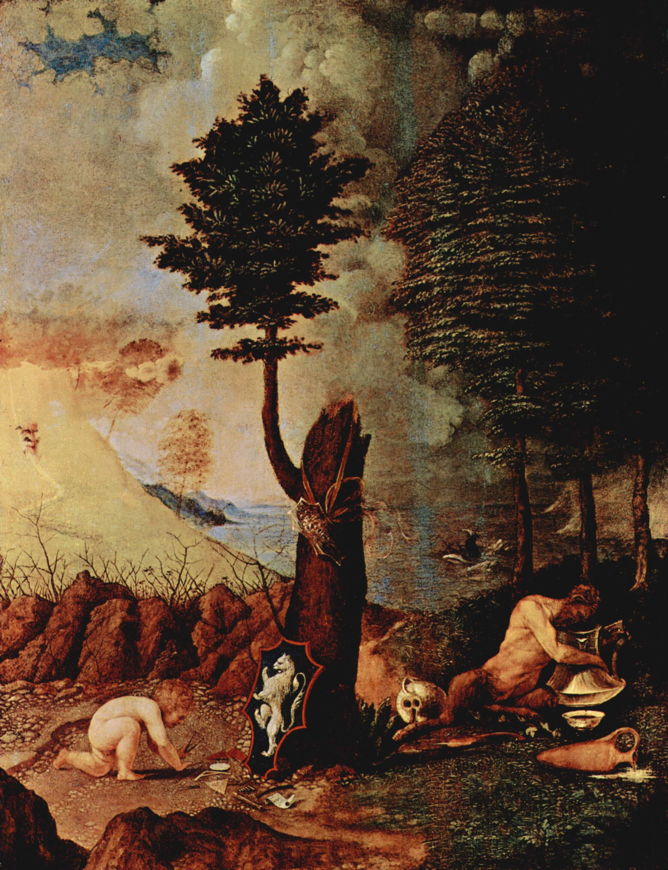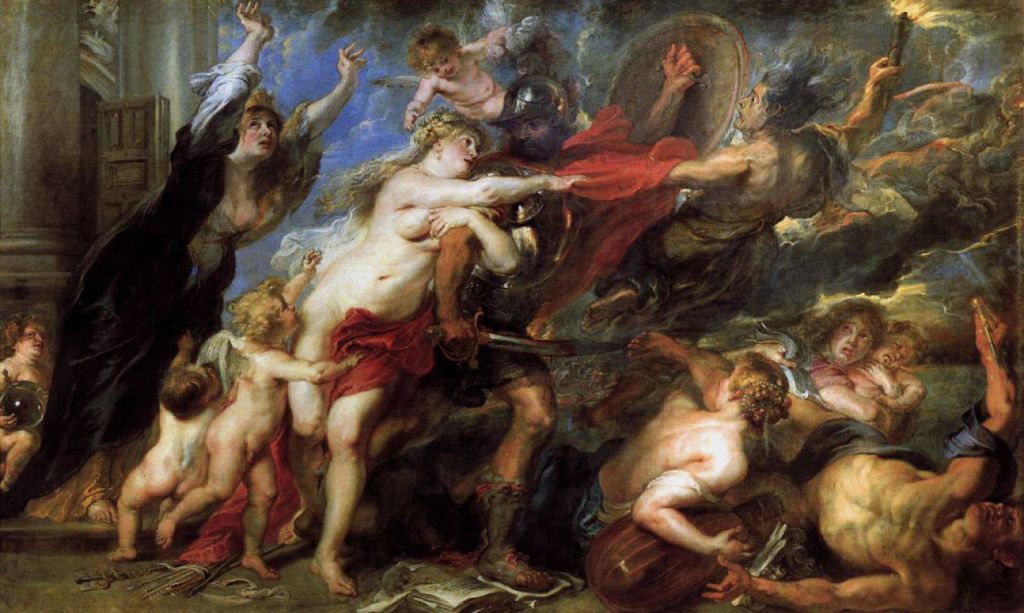The great majority of paintings show what we can see: people, landscapes, vases of flowers, and everything else in the world around us. Sometimes the artist wants to express non-visual concepts such as the senses, virtues, even the struggle between good and evil. One long-established method of delivering a non-visual message using visible objects is to cast the painting in an allegory. Within that allegory, intangibles are often represented by human figures, personifications of that concept or idea.
This weekend I’m going to look at some great allegorical paintings to illustrate this technique. This article looks at grand allegory, while tomorrow’s looks more narrowly at personification. These paintings can be some of the most difficult to read: if you don’t understand the visual language being used, you may come away utterly confused. I’ll do my best to be your guide.
Allegorical paintings were very popular during the Renaissance, particularly in Italy, but by the end of the seventeenth century became less frequent.

Bellini’s Allegory of Winged Fortune (1490) looks weird today because of its use of contemporary symbolic associations, most of which have been forgotten in the centuries since. The following symbolic devices can be read here:
- the blindfold represents Fortune’s salient characteristic, her blindness in dispensing good fortune and misfortune;
- ill fate is normally associated with a peacock tail, wings, and lion’s paws;
- the two pitchers represent the dispensation of good and bad fortune;
- abundant and long hair at the front of the head, and little at the back, symbolises Kairos, the moment of opportunity, which can be seized by the hair when approaching, but once passed cannot.
Painters had collections of images with established symbolic associations which they used to compose such allegories. Fortunately some were published in sufficient quantities as to have survived, to assist in modern interpretation.

Even armed with an extensive reference to the symbols used, some paintings seem to defy rational interpretation. I’m sure that Lotto’s Allegory of Prudence and Wisdom from 1505 meant something to his contemporaries, but few can interpret it today.

One of the most famous allegories was the Calumny of Apelles, here reconstructed from Lucian’s description of a long-lost painting by the ancient Greek artist Apelles, here painted by Botticelli in about 1496-7. This shows an innocent young man about to be badly misjudged by King Midas.
The youth who is the victim of the calumny is being dragged by his hair, clad only in a loincloth, with his hands pressed in prayer. On the throne at the right, perched on a dais, sits Midas, with ass’s ears, extending his right hand towards the distant figure of Slander. On either side of Midas are Ignorance and Suspicion, speaking simultaneously into those ears.
Slander is shown as a beautiful woman, holding a blazing torch in her left hand, and the accused’s hair in her right. At her left, between Slander and Midas, is Envy, who reaches his left hand out towards Midas’ eyes. The two women attending Slander are Fraud and Conspiracy. To the left is Repentance, dressed in deep mourning, her clothing in tatters. She glances back at the naked Truth, who looks up to the gods.
Botticelli recreated this painting by assembling the personifications of the vices and virtues involved in the case.
Late in the sixteenth century, these rather strained compositions were replaced by allegories which showed more mature and integral composition.

Tintoretto’s marvellous painting of Minerva and Mars from 1578 is an early example in which the goddess is pushing the god of war away from her, as her right hand rests on the shoulder of Peace, with Prosperity at the left edge of the canvas.

Some allegorical subjects became particularly favoured, including various arrangements of truth and time, as seen in Annibale Carracci’s Allegory of Truth and Time from 1584. The winged Father Time lacks his usual scythe but is putting his shoulder to Truth to raise her from a well, and she clutches a mirror in her right hand.
Trampled under the feet of Truth is the strangely chimeral two-faced figure of Deceit. The two figures framing the image are more controversial: the official identification gives them as Good Luck or Happiness on the left, and Happy Ending on the right. That on the left bears a winged caduceus and a cornucopia (horn of plenty), which is an unusual combination which may allude to good health as well as abundant food. That on the right is scattering Spring flowers, which might relate her to Flora.
It was Peter Paul Rubens who painted some of the grandest of these mythical allegories, which form the basis of much of his Marie de’ Medici Cycle.

The Felicity of the Regency shows Marie on her throne, in the role of the personification of Justice. At her left are Minerva (in her armour with her Aegis) and Prudence, around whose right arm a snake indicates serpentine wisdom. At the far right is Abundance carrying her cornucopia.
At the left is Saturn, who holds his scythe signifying the march of time. Above them are two figures of Fama (Fame or Pheme) blowing fanfares on their trumpets. Below are Envy, Ignorance, and Vice, together with four attendant putti.
Rubens wrote optimistically that this shows the flowering of the Kingdom of France, under Marie’s rule of prudence and equity. Sadly, history just didn’t work out that way.

With Europe nearing the end of the Thirty Years’ War, Rubens was only too delighted to be commissioned to paint one of his final narrative masterpieces for Ferdinand de’ Medici, then the Grand Duke of Tuscany. Tuscany had been largely uninvolved in the war, and at this time Rubens had no diplomatic mission to accomplish. He could afford to be frank in his story, and we are fortunate in having the artist’s own description of the painting as a reference.
The central figures in The Consequences of War (1637-38) are Venus and Mars. The god of war is advancing forcefully having just rushed from the temple of Janus, moving from left to right, with his sword bloodied and held low. His head is turned back to look at Venus, whose left arm is caught around his right, and who is clearly trying unsuccessfully to restrain him. Standing against the right thigh of Venus is a winged Cupid, the child of Mars and Venus.
Drawing Mars forward is Alecto, her hair here looking more like that of a Fury but with few snakes visible, who bears a torch in her right hand. Monsters near her personify Pestilence and Famine, the inseparable partners of war at that time. On the ground below Alecto is a woman with her back towards the viewer: she is Harmony, whose lute has been broken in the discord brought by war.
Nearby, also on the ground, is a mother with her child in her arms, symbolising the effect of war on families and their rearing. At the lower right corner is an architect clutching his instruments, indicating how fine buildings are thrown into ruin by war. Under the right foot of Mars is a book, showing how war tramples over the arts. On the ground to the left of Cupid is a bundle of arrows or darts: these are not Cupid’s arrows of desire, but when bundled up would form the symbol of Concord; thus war breaks Concord. To their left is the caduceus and an olive branch, attributes of Peace, also cast aside.
The woman at the left in a black gown is the personification of Europe, whose globe (symbolising the Christian world) is carried by a putto behind her. Having endured the ravages of war for so long, her clothing is torn and she has been robbed of her jewels. Venus and Mars are, in myth, well-known lovers. Venus is failing to restrain Mars from charging off to war, and in doing so, he is breaking their bond of love.

Earlier in Rubens’ career, he had collaborated with his friend Jan Brueghel the Elder to paint a magnificent series of five allegories of the senses, among them Sight from 1617. Amid the cornucopia of visual and optical artefacts shown here is a sophisticated telescope, various drawing and navigational instruments which relied on sight (for making sightings), an early magnifying glass, a globe and an orrery (showing the orbits of the planets), and a vast collection of visual art, including paintings and sculpture.
There are some obvious figurative items, such as the peacocks shown in the distance, just above the woman’s head: their feathers have eye-like markings, and refer to the well-known myth of Argus.

Painting itself became another popular theme for allegory. Bernardo Strozzi’s Allegory of Painting from 1635 is unusual for the appearance of a woman, who holds in her right hand the top of a canvas, and her left hand bears a palette, on which there are oil paints, and half a dozen brushes. One symbol common to all examples of this allegory are brushes, an obvious reference to painting. Almost as common are the palette and oil paints on its surface.

During the seventeenth century, Vanitas paintings became another sub-genre which attracted an allegorical approach. Carstian Luyckx’s undated Allegory of Charles I of England and Henrietta of France in a Vanitas Still Life is an unusually florid combination of allegory, Vanitas and a still life – the latter an unusual association for allegory.
The symbols here include a globe, the physical world itself, the gall from a tree, a snuffed-out candle, seashells, and coral. Luyckx uses another common device found in Vanitas painting: an open book, here showing King Charles I, who was executed in 1649, and his wife Henrietta Maria of France, who was deposed as queen of England by the civil wars, which forced her to flee to France in 1644.

Some later Vanitas paintings developed the allegory of young boys blowing bubbles, as in Karel Dujardin’s Boy Blowing Soap Bubbles, an Allegory on the Transitoriness and Brevity of Life (1663).
By the end of that century, allegories had become unusual in painting, replaced to a degree by personifications, as I will show in the next article. But I have come across one superb example of a complex allegory painted in the early twentieth century, of which I am sure even Rubens would have been proud.

Osman Hamdi Bey’s magnificent The Tortoise Trainer from 1906 set the record for the highest price paid for a Turkish painting when it was sold in 2004 for $3.5 million.
Its ingenious allegory can be read in at least two ways. The artist may have been self-critical of his painstakingly slow work; tortoises are not only inherently slow, but in the early eighteenth century had been used in Istanbul to bear lit candles for evening outings. This painting also had a greater political meaning, as the tortoise trainer wears traditional Ottoman religious costume from before the middle of the nineteenth century, and is training the tortoises with a traditional Turkish ney flute.
In that sense, it is a satire on the slow, faltering, and often ineffective reforms made to the Ottoman Empire during the late nineteenth century, an issue with which Hamdi Bey had much personal experience. This resulted in a time of increasing social and political upheaval, preceding the Young Turk Revolution of 1908 which changed the basis of rule in the empire, followed by the breakup of the empire after the First World War.

